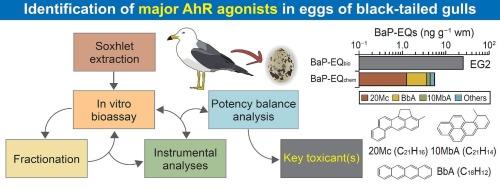韩国黑尾鸥蛋中ahr活性物质的效应导向分析和非靶标筛选
IF 9.7
1区 环境科学与生态学
Q1 ENVIRONMENTAL SCIENCES
引用次数: 0
摘要
本研究利用效应导向分析和非靶筛选(NTS)技术鉴定了韩国黑尾鸥(Larus crassirostris)卵中主要的芳烃受体(AhR)激动剂。通过h4ie -luc生物测定,在蛋提取物的中极部分(F2)中观察到显著的ahr介导效价,在亚段F2.3和F2.6-F2.9中检测到显著的活性,对应的log KOW范围分别为2.0-3.0和5.0-9.0。14种靶向AhR激动剂,包括传统的多环芳烃(PAHs),新兴的PAHs (e-PAHs)和苯乙烯低聚物,占AhR介导总效力的15 - 61% %。其中,20-甲基胆蒽(14 %)、苯并[b]蒽(8.8 %)和10-甲基苯并[a]芘(4.5 %)等e-多环芳烃对ahr介导的总效价贡献很大。在F2.3和F2.6-F2.9上使用GC-QTOFMS的NTS通过五步选择过程确定了24种AhR激动剂候选物。在现有标准的候选物中,1,4-双环己基苯在h4ie -luc生物测定中显示出显著的ahr介导活性。该化合物在鸡蛋提取物中检测到的浓度范围为0.25至5.1 ng g−1湿质量。然而,由于其相对效价较低(7.0 × 10−4),与苯并[a]芘相比,其对ahr介导的总效价的贡献平均仅为0.01 %。母体移植的AhR激动剂在卵子中的log KOW和log KOA值分别在5.0 ~ 8.0和6.5 ~ 11.5之间。本研究首次在黑尾鸥的卵中发现了母体转移的AhR激动剂,为这些污染物的生态和毒理学风险提供了新的见解。本文章由计算机程序翻译,如有差异,请以英文原文为准。

Effect-directed analysis and nontarget screening for identifying AhR-active substances in black-tailed gull eggs from South Korea
This study identifies major aryl hydrocarbon receptor (AhR) agonists in the eggs of black-tailed gulls (Larus crassirostris) from South Korea using effect-directed analysis and nontarget screening (NTS). Significant AhR-mediated potency is observed in the mid-polar fraction (F2) of the egg extracts, as determined by the H4IIE-luc bioassay, with notable activity detected in subfractions F2.3 and F2.6–F2.9, corresponding to log KOW ranges of 2.0–3.0 and 5.0–9.0, respectively. Fourteen targeted AhR agonists, including traditional polycyclic aromatic hydrocarbons (PAHs), emerging PAHs (e-PAHs), and styrene oligomers, account for 15–61 % of the total AhR-mediated potency. Among them, e-PAHs such as 20-methylcholanthrene (14 %), benzo[b]anthracene (8.8 %), and 10-methylbenzo[a]pyrene (4.5 %) contribute substantially to the overall AhR-mediated potency. NTS using GC-QTOFMS on F2.3 and F2.6–F2.9 identifies 24 AhR agonist candidates through a five-step selection process. Among the candidates with available standards, 1,4-dicyclohexylbenzene shows significant AhR-mediated activity in the H4IIE-luc bioassay. This compound is detected in egg extracts at concentrations ranging from 0.25 to 5.1 ng g−1 wet mass. However, due to its low relative potency value (7.0 × 10−4) compared to benzo[a]pyrene, its contribution to overall AhR-mediated potency is only 0.01 %, on average. The log KOW and log KOA values of the maternally transferred AhR agonists in the eggs range from 5.0 to 8.0 and 6.5 to 11.5, respectively. This study represents the first identification of maternally transferred AhR agonists in the eggs of black-tailed gulls, providing new insights into the ecological and toxicological risks associated with these contaminants.
求助全文
通过发布文献求助,成功后即可免费获取论文全文。
去求助
来源期刊

Environment International
环境科学-环境科学
CiteScore
21.90
自引率
3.40%
发文量
734
审稿时长
2.8 months
期刊介绍:
Environmental Health publishes manuscripts focusing on critical aspects of environmental and occupational medicine, including studies in toxicology and epidemiology, to illuminate the human health implications of exposure to environmental hazards. The journal adopts an open-access model and practices open peer review.
It caters to scientists and practitioners across all environmental science domains, directly or indirectly impacting human health and well-being. With a commitment to enhancing the prevention of environmentally-related health risks, Environmental Health serves as a public health journal for the community and scientists engaged in matters of public health significance concerning the environment.
 求助内容:
求助内容: 应助结果提醒方式:
应助结果提醒方式:


